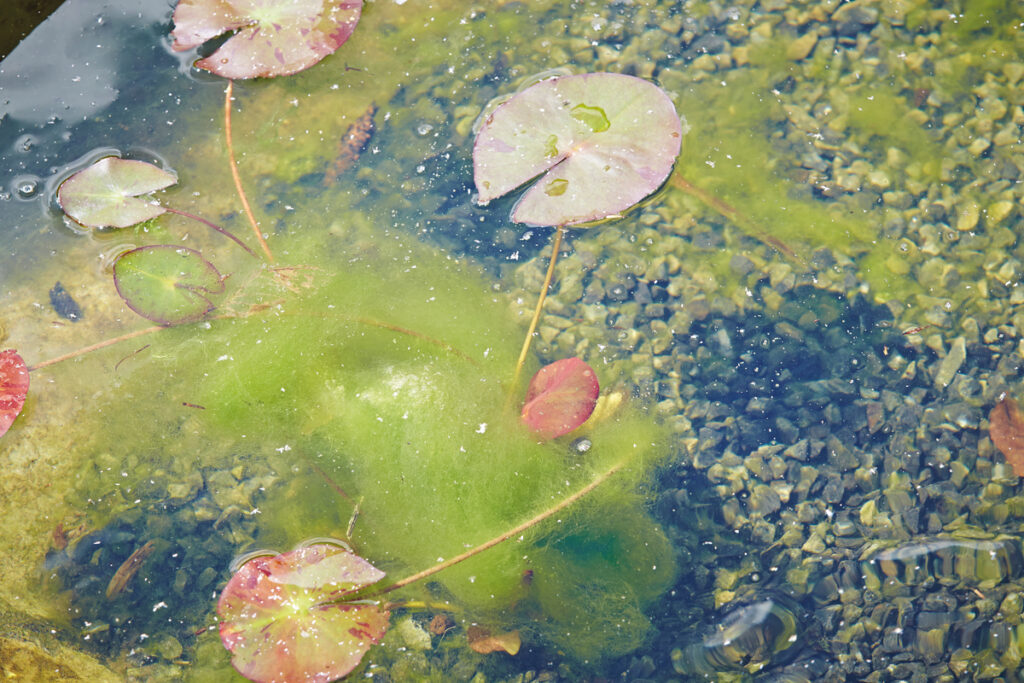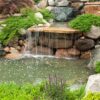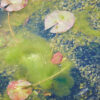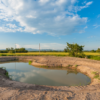A pond can be a lovely and ornamental addition to a yard or house, but if the water is dark and filthy with algae, it might lose some of its appeals. It is really disturbing to see your pond become green due to algae.
Nothing is worse than witnessing your pond in this situation. As we know that algae is a filamentous type known as string algae, and it hangs in rocks in ponds and float on the water’s surface. Long threads of algae entangle and produce dense mats. The long strings of algae tangle form thick mats that can double their weight within 24 hours! This situation makes your pond appearance ugly.
But you must keep in mind that a small number of algae are a normal part of the pond ecosystem but it would be dangerous for fish health if its growth becomes excessive and hard to handle. The main goal is to eliminate algae without causing any harm to your fish.

Here is a guide on how you can remove algae naturally and chemically from your pond:
- Physical Removal
- Add Floating Plants & Remove Decay
- Fish Feeding
- Use Barley
- UV Clarifier
- Ionizer
- Use Algaecide
- Remove leftover Decomposing Algae
- Add extra Aeration
- Water Treatment
- Keep your Nitrates and Phosphates in Check
- Support Your Fish During Algae Bloom
- Limit your Pond’s Sunlight
Physical Removal:
This is one of the most effective and fastest methods to get rid of algae and make your pond water crystal clear. Although it is somehow dirty it will work eventually. The amount of decay can be reduced in this way. You can remove them by scrapping them hard. It would take some time but it’s quite effective. Sometimes it’s difficult because it slips from the hands due to its malleable nature. To remove the algae at depth, use a long-handled brush.
Add Aquatic Plants
Aquatic plants draw nutrients from your pond that helps algae grow. Algae is a living thing that needs nutrients from the water to survive. You should be able to find a wide variety of plants ideal for your pond at your neighborhood nursery or garden center. If you’re unsure of the ideal plant varieties to utilize, inquire. Approximately 60% of your pond’s surface should be covered with plants for the greatest results. Lily pads, cattails, or watercress are some other eye-catching plants you may add to your pond that will absorb all of those nutrients and prevent algae growth. For the spring and summer, we advise water lettuce and irises. This can make your water pure and increse the aesthetics of your pond.
Plants with rapid expansion and growth should be added to your pond to boost the oxygen level. The rotting plants must be removed first because they won’t aid in the battle against algae. Pick plants that will thrive in your environment, grow larger, and require little maintenance. The growth of algae in ponds is regulated by floating plants that offer shade and cut down on direct sunlight. Make sure to occasionally remove some of your surplus plants to allow your pond to experience new growth.

All aquatic vegetation eats up nutrients, starving algae. These are also good at absorbing nutrients and acting as a canopy. The construction of a plant filter is a well-liked method of introducing vegetation to the pond system without doing so in the main pond.
Fish Feeding
Overfeeding fish, which results in an excess of nutrients in the water, is one of the most frequent mistakes made by owners of fish ponds. You’ve overfed your fish if there is any food still in the pond that hasn’t been consumed. By feeding the fish less frequently, you also boost their desire for other pond creatures. such as in algae!
Use Barley
To gradually eliminate the algae, add barley straw to the pond. Barley is a great all-natural way to keep ponds clear and clean, and it is safe to use in ponds containing fish and other species. Barley straw will gradually release little amounts of hydrogen peroxide as it rots, which will destroy any algae in your pond. When you first detect algae blooming in your pond, purchase a small bale of barley straw and drop it into the pond. You need to observe the algae in your pond fading after a few weeks. A fantastic organic thing to utilize is barley straw.
UV Clarifier
Installing a UV clarifier in a pond is a practical solution to get rid of cloudy water. They are a fantastic solution for ponds in full sun to block off too much light. The ultrafine particles that create discolored water are destroyed by UV clarifiers. When a particle is killed, it clumps with other dead particles, which your mechanical filter then removes.
Ionizer
To keep the water pure and lessen the growth of string algae, copper ionizers for ponds discharge copper ions into the water. Ionizers need pumps with a minimum flow rate to liberate the ions from the anode. By putting ionizers in line with plumbing or inserting a drop-in model into your pond skimmer, ponds—new or old—can easily incorporate ionizers.
Use Algaecide
Adding an algaecide with a copper base to destroy visible algae is the most popular way to manage algae growth. Even though an algaecide could occasionally be helpful, you must use caution while using it. Algae can have its own set of issues from oxygen depletion, including harmful effects for fish, native plants, and wildlife if it is overused or killed out too rapidly. When the algae are killed, the amount of extra organic material increases. As a result, the algae issue will recur frequently.
Remove Leftover Decomposing Algae
For long-term algae control, some of that extra organic matter must be broken down. 3 to 24 inches of organic materials can be found on the bottom of many ponds. As this organic stuff breaks down, surplus nutrients are released, and this process is accelerated if there is a lack of oxygen in the pond’s deeper regions.
Add Extra Aeration
The most crucial thing you can do to aid with long-term algae prevention in your pond is to add aeration and circulation. Aeration raises the amount of dissolved oxygen in the pond’s bottom, which boosts the population of aerobic microorganisms. The amount of nutrients released is then decreased as a result of these bacteria starting to consume the extra organic matter.
Keep your Nitrates and Phosphates in Check
Eliminating your algae’s food source is the greatest way to control your algae problem. There isn’t much that can be done to prevent phosphates because they often enter your source water. The nitrogen cycle ends with nitrates, so if you feed your fish frequently or consume a high-protein diet, your nitrate levels may increase.
Limit your Pond’s Sunlight
Algae thrive in areas with lots of sunlight. To restrict the amount of light reaching your pond, if at all possible, place a sun sail or umbrella to the edges of it. Along with stabilizing the temperature of your pond, this will shield your fish from UV rays harm.
Support Your Fish During Algae Bloom
Your pond has a lot of algae, thus Changes in pH and a lack of oxygen could be harmful to your fish. Algae perform photosynthesis during the day and generate a lot of oxygen. However, algae will engage in cellular respiration at night, using oxygen to create carbon dioxide. If the algae are present in large amounts, the oxygen may be completely consumed, leaving no oxygen for the fish. If your filter does not operate continuously, this is very crucial. If your isn’t high enough, high carbon dioxide concentrations can lead to a pH fall, which can harm your fish as well.
Build your Pond In A Shady Area
If you’re still designing a new pond, think about situating it where there isn’t much sunshine because algae need light to develop. To prevent algae from growing, try creating a pond next to a tall wall or cover the area with a shade mat.
Large trees may drop leaves into the pond, so you shouldn’t rely on their shade. Fallen leaves will eventually decompose and allow algae to bloom, requiring more frequent pond cleaning. Custom-made barriers like shade mats and sails will keep too much sunshine from entering your pond. They ought to be accessible online or at specialty pond shops.
That is all there is to know about eliminating algae from your pond. Keep in mind that proactive management of your pond will help keep it clear, allowing you to enjoy it more and spend less time maintaining it.










